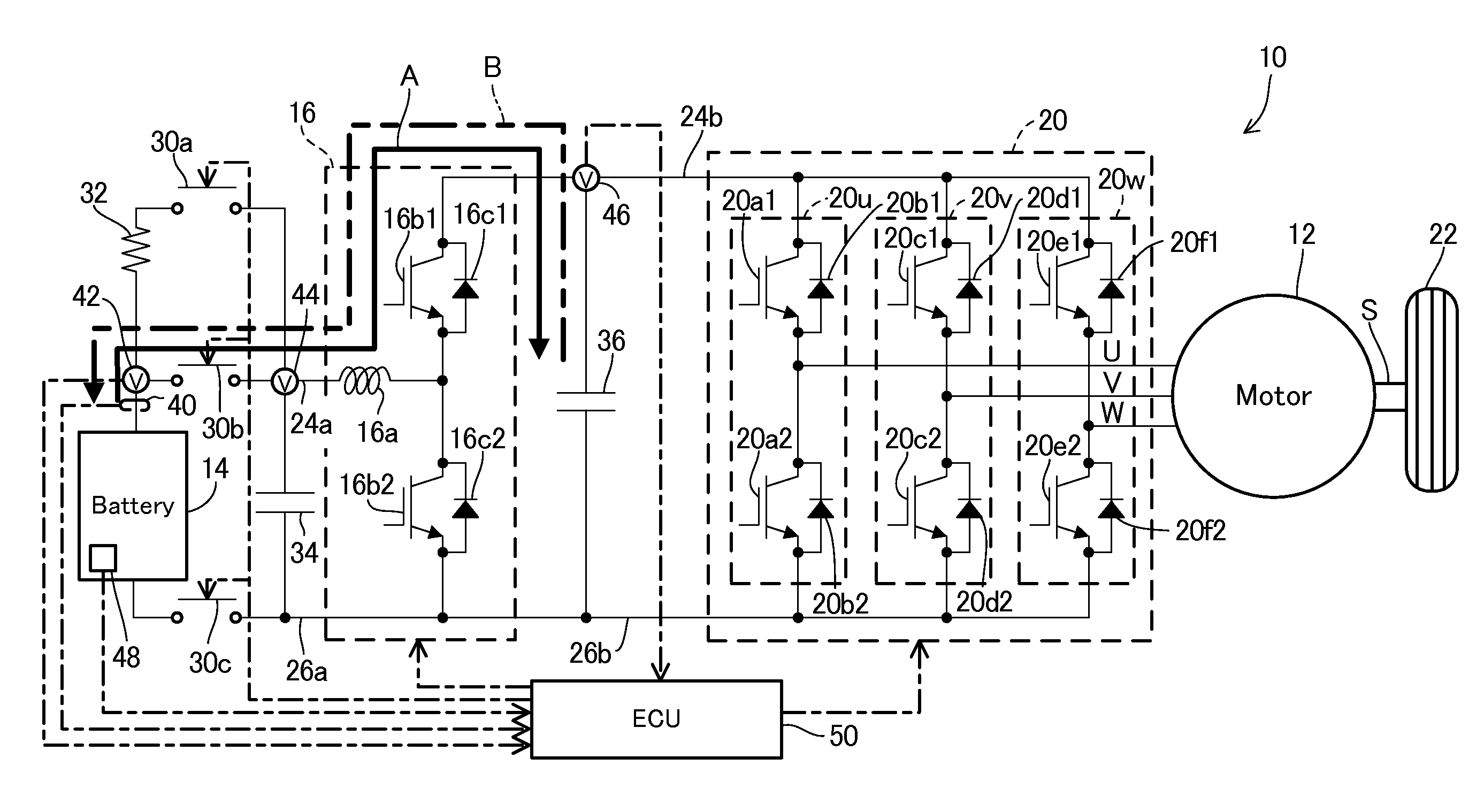Battery heating apparatus for vehicle
a technology for heating apparatus and batteries, which is applied in the direction of battery/fuel cell control arrangement, electric devices, electrochemical generators, etc., can solve the problems of adversely affecting the size of the device, increasing the size and complexity of the device, and unable to achieve effective heating of the battery, so as to achieve the effect of efficient heating of the battery and adversely affecting the size of the apparatus
- Summary
- Abstract
- Description
- Claims
- Application Information
AI Technical Summary
Benefits of technology
Problems solved by technology
Method used
Image
Examples
first embodiment
[0020]FIG. 1 is an overall view schematically showing a battery heating apparatus for a vehicle according to this invention.
[0021]In FIG. 1, reference numeral 10 designates the vehicle. The vehicle 10 comprises an electric vehicle (EV) equipped with an electric rotating machine (indicated as “Motor” in the FIG. 12, a battery 14 and a buck-boost (step-up / down) converter 16 and inverter 20 that are interposed between the battery 14 and rotating machine 12.
[0022]The rotating machine 12 comprises a brushless AC synchronous motor and upon being supplied with current, transfers a rotational output to a wheel (driven wheel) 22 through a connecting shaft S to make the vehicle 10 travel. The rotating machine 12 has a regeneration function to convert kinetic energy generated with rotation of the connecting shaft S into electric energy and output it during deceleration. Specifically, the rotating machine 12 serves as a motor when rotated with the current supply and as a generator when rotated ...
second embodiment
[0084]A battery heating apparatus for a vehicle according to the invention will be explained.
[0085]In the second embodiment, the frequency and amplitude of the pseudo-AC current are determined by retrieving the characteristics (mapped data) set beforehand.
[0086]FIG. 8 is a flowchart similar to FIG. 3, but showing the operation of heating control by the ECU 50 of the apparatus according to the second embodiment.
[0087]As shown in FIG. 8, the steps of S100 to S104 are processed similarly to those of S10 to S14 in the first embodiment. Then the program proceeds to S106, in which the frequency and amplitude of the current Ibat flown through the battery 14 are determined by retrieving the mapped values using the temperature T, SOC, battery capacitance and internal resistance of the battery 14 (including gains used for controlling the level (strong / weak) of the heating control in accordance with the battery capacitance and internal resistance (i.e., the condition (degradation condition) of...
PUM
| Property | Measurement | Unit |
|---|---|---|
| voltage | aaaaa | aaaaa |
| temperature Tthre1 | aaaaa | aaaaa |
| frequency | aaaaa | aaaaa |
Abstract
Description
Claims
Application Information
 Login to View More
Login to View More - R&D
- Intellectual Property
- Life Sciences
- Materials
- Tech Scout
- Unparalleled Data Quality
- Higher Quality Content
- 60% Fewer Hallucinations
Browse by: Latest US Patents, China's latest patents, Technical Efficacy Thesaurus, Application Domain, Technology Topic, Popular Technical Reports.
© 2025 PatSnap. All rights reserved.Legal|Privacy policy|Modern Slavery Act Transparency Statement|Sitemap|About US| Contact US: help@patsnap.com



